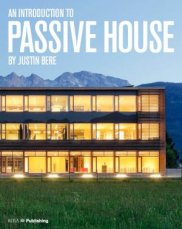Main author
Michael BrooksAn Introduction to Passive House - review
Justin Bere - ‘An Introduction to Passive House’
Published by RIBA Publishing (2013)
Written by the architect Justin Bere, this introductory guide to the Passive House standard is an accessible and valuable addition to the growing content relating to construction fit for a sustainable 21st century.
The slim and well-presented volume begins with a section called ‘What is Passive House?’ which concisely explores the history and growing prevalence of the Passivhaus Standard. Bere explains that Passive House is a standard for, and advanced method of, designing buildings using building physics to ensure precision, comfort and reduced energy costs, as well as removing guesswork from the design process.
He also presents the opinion that:‘A great 21st century building is one that is beautiful to look at but that also feels good in reality when the power supplies are turned down to almost nothing … I fear that some architects give more priority to how their buildings will look in architectural magazines than to making sure that their buildings perform efficiently and comfortably for the benefit of their occupants.’
The book explores the six methods that form the essential basics of Passive House design:
- Insulation.
- Draught-free construction.
- High-performance windows and doors.
- Heat recovery ventilation.
- Good building commissioning.
- Solutions for both hot and cold climates.
While the book does not provide a great deal of detail, Bere does set out the context and easy-to-understand basics for those who may not be familiar with the subject.
The second section asks ‘Why Passive House?’, and provides more technical information and discussion covering the renewable energy revolution, integrated design, and capital and whole life costs. Two shorter chapters provide robust primers on air quality and health, and the importance of skills.
The bulk of the book though is taken up with 15 case studies from around the world. These include a variety of different buildings other than houses, including an office, community centre and school, and emphasise the potential that following the Passive House Standard can have in delivering buildings of great architectural merit.
There are eye-catching photographs, details and diagrams throughout that make it a great book to flick through, while providing enough technical information to serve as a worthwhile and engaging introduction, and perhaps as inspiration, to both students and seasoned professionals.
[edit] Related articles on Designing Buildings
- Active House.
- Ancona eco-mansion.
- Better Buildings: Learning from buildings in use - review.
- Bill Gething and Katie Puckett - Design for Climate Change.
- BIM for Dummies - an interview.
- Biomimicry in Architecture - review.
- Charles Waldheim - Landscape as Urbanism: A General Theory.
- Fabric first.
- FutuREstorative - review.
- Green deal.
- Home Quality Mark.
- How Buildings Work - review.
- Owen Hatherley - Landscapes of Communism.
- Passivhaus.
- Sustainability.
- Zero carbon homes.
Featured articles and news
The UK's Modern Industrial Strategy: A 10 year plan
Previous consultation criticism, current key elements and general support with some persisting reservations.
Building Safety Regulator reforms
New roles, new staff and a new fast track service pave the way for a single construction regulator.
Architectural Technologist CPDs and Communications
CIAT CPD… and how you can do it!
Cooling centres and cool spaces
Managing extreme heat in cities by directing the public to places for heat stress relief and water sources.
Winter gardens: A brief history and warm variations
Extending the season with glass in different forms and terms.
Restoring Great Yarmouth's Winter Gardens
Transforming one of the least sustainable constructions imaginable.
Construction Skills Mission Board launch sector drive
Newly formed government and industry collaboration set strategy for recruiting an additional 100,000 construction workers a year.
New Architects Code comes into effect in September 2025
ARB Architects Code of Conduct and Practice available with ongoing consultation regarding guidance.
Welsh Skills Body (Medr) launches ambitious plan
The new skills body brings together funding and regulation of tertiary education and research for the devolved nation.
Paul Gandy FCIOB announced as next CIOB President
Former Tilbury Douglas CEO takes helm.
UK Infrastructure: A 10 Year Strategy. In brief with reactions
With the National Infrastructure and Service Transformation Authority (NISTA).
Ebenezer Howard: inventor of the garden city. Book review.
The Grenfell Tower fire, eight years on
A time to pause and reflect as Dubai tower block fire reported just before anniversary.
Airtightness Topic Guide BSRIA TG 27/2025
Explaining the basics of airtightness, what it is, why it's important, when it's required and how it's carried out.
Construction contract awards hit lowest point of 2025
Plummeting for second consecutive month, intensifying concerns for housing and infrastructure goals.
Understanding Mental Health in the Built Environment 2025
Examining the state of mental health in construction, shedding light on levels of stress, anxiety and depression.























